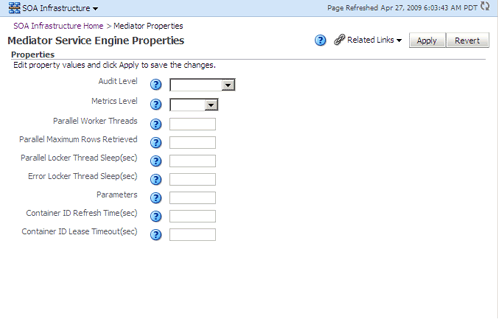13 Configuring Oracle Mediator Service Components and Engines
This chapter describes how to configure Oracle Mediator (Mediator) service components and service engines.
This chapter includes the following topics:
-
Section 13.4, "Configuring Parameters for Parallel Infrastructure"
-
Section 13.5, "Configuring Parameters for Error/Retry Infrastructure"
-
Section 13.6, "Configuring Parameters for Heartbeat Framework"
13.1 Introduction to Configuring Oracle Mediator
You can configure the properties of Mediator Service Engine by setting the parameters mentioned in this chapter. These parameters can be set in the following ways:
-
By setting the values of the parameters in the Mediator Service Engine Properties page:

Description of the illustration med_prop_n.gif
Perform the following steps to display the Mediator Service Engine Properties page:
-
Open the SOA Infrastructure Home page.
-
From the SOA Infrastructure menu, select SOA Administration and then Mediator Properties.
-
-
By setting the values of the parameters in an MBean browser:
Perform the following steps to set the values in an MBean browser:
-
From the SOA Infrastructure menu, select Administration and then System MBean Browser
The System MBean Browser page is displayed.
-
Expand the node oracle.as.soainfra.config in the left pane (below the page title).
The Server:soa_server1 node is displayed.
-
Expand the Server:soa_server1 node.
The MediatorConfig node is displayed.
-
Expand the MediatorConfig node.
The mediator MBean is displayed.
-
Click the mediator MBean.
The properties of the MBean are displayed on the right pane.
-
Change the value of the properties and click Apply.
-
Note:
You do not need to restart the server for changing these properties.13.2 Configuring Audit-Level Flags
You can configure the Mediator-specific auditLevel flag for audit levels. The value of this flag overrides the value of the global SOA infrastructure audit-level flag. The possible values of this flag are:
-
Off- Switches off auditing of Mediator. Composite instance tracking and payload tracking information are not collected. -
Inherit- Level of audit is the same as the SOA infrastructure. This setting enables the Mediator audit level to automatically change, when the global setting is changed. Setting a different audit level tracking, for this page, overrides the tracking set at the SOA Infrastructure level. -
Production- All events are logged. All audit details, except the details of assign activities, are logged. Instance tracking information is collected, but payload details are not captured and these details are not available in the flow audit trails. This level is optimal for most typical operations and testing. -
Development- All events and all audit details are logged. In addition, payload details are captured and are available in the flow audit trails. This level is useful for debugging purposes, but may impact performance.
The default value of this flag is Inherit.
Note:
Audit levels were known as instance tracking levels in the Oracle Application Server 10g releases.13.3 Configuring Metrics-Level Flag
You can set the Mediator-specific flag metricsLevel for configuring the Dynamic Monitoring Service (DMS) metrics level. DMS metrics are used to measure the performance of application components. The possible values of this flag are:
-
Enabled- Enables DMS metrics tracking -
Disabled- Disables DMS metrics tracking
13.4 Configuring Parameters for Parallel Infrastructure
You can configure the parallel infrastructure by setting the following parameters:
-
ParallelWorkerThreadCount- Specifies the number of parallel dispatchers for message processing. Increase this parameter to increase the number of outbound threads for parallel processing. -
ParallelMaxRowsRetrieved- Specifies the number of rows retrieved per iteration for parallel processing. You can set the value of this parameter to 50 to 100 times of theParallelWorkerThreadCountparameter, depending on the memory consumption limit.Note:
A large value for theParallelMaxRowsRetrievedparameter can result in memory exhaustion. -
ParallelLockerThreadSleep- Specifies the idle time between two successive iterations for retrieving rows, when there is no message for parallel processing. The time is measured in seconds.
13.5 Configuring Parameters for Error/Retry Infrastructure
You can configure the error/retry infrastructure by setting the following parameter:
-
ErrorLockerThreadSleep- Specifies the idle time between two successive iterations for retrieving errored out messages, when there is no errored out message from parallel processing. The time is measured in seconds.
13.6 Configuring Parameters for Heartbeat Framework
The heartbeat infrastructure is a part of the Mediator Service Engine and is used to detect the absence of a Mediator Service Engine instance due to failure or shutdown of a node. The heartbeat infrastructure creates a unique identifier for each instance of the Mediator Service Engine and performs the necessary house-keeping tasks, if a Mediator Service Engine fails. The heartbeat infrastructure consists of a heartbeat thread. The heartbeat thread periodically updates the time stamp associated with each Mediator Service Engine's unique identifier. By updating the time stamp associated with it, a Mediator Service Engine announces its presence to the other Mediator Service Engines. The heartbeat thread also checks if there are unique identifiers that have not been updated for a particular period of time. You can configure the heartbeat Framework by setting the following parameters:
-
ContainerIdLeaseRefresh- Specifies the time interval at which the heartbeat thread periodically updates the time stamp associated with each Mediator Service Engine's unique identifier.Note:
-
The default value of the
ContainerIdLeaseRefreshparameter is 60 seconds. -
In case of unplanned outages, you must wait as much time as specified as the
ContainerIdLeaseRefreshinterval, after restarting the server. The server requires this much time to complete the instances still in the running state.
-
-
ContainerIdLeaseTimeout- Specifies the time interval at which the heartbeat thread periodically checks if there are unique identifiers that have not been updated for a particular period of time.
By configuring these parameters, you can specify the period used by the heartbeat thread to detect the failure of a Mediator Service Engine.
Note:
-
The default value of the
ContainerIdLeaseRefreshparameter is 60 seconds. -
In case of unplanned outages, you must wait as much time as specified as the
ContainerIdLeaseRefreshinterval, after restarting the server. The server needs this much time to complete the instances still in the running state.